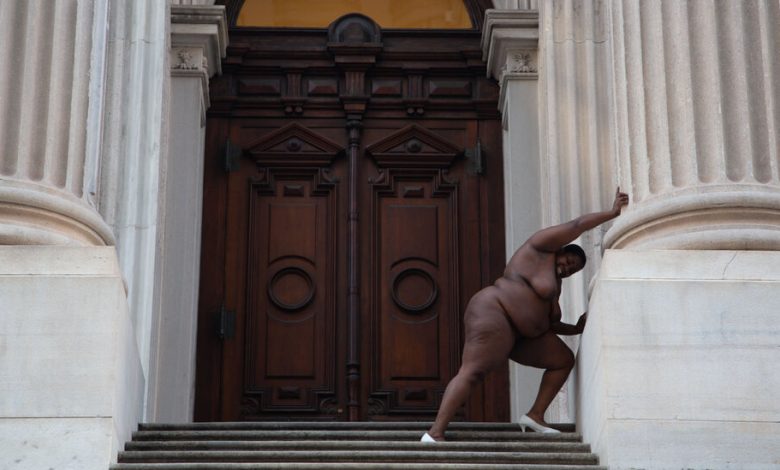Nona Faustine Never Leaves the Frame

It makes perfect sense that Nona Faustine’s introduction to professional photography was through photojournalism. While her photographs are always premeditated and posed, their primary intent is to calcify a particular moment in time to ensure that she — and we — never forget it.
Her photo series “White Shoes,” her most historically anchored project, is on display in its entirety for the very first time at the Brooklyn Museum. The show consists of 43 self-portraits that memorialize locations throughout New York City’s five boroughs and areas of Long Island with underrecognized histories of slavery, from spaces as green as Brooklyn’s Botanical Garden to the trash-covered asphalt of Wall Street.
In this striking series, the artist typically poses blank-faced and nude, save a pair of white high heels — a nod to the church shoes historically worn by Black women as well as a symbol of the predominantly white country Black Americans have inhabited, and fought to reshape, since the early days of the slave trade. Sometimes, Faustine punctuates her nudity with a veil or a scarf draped over her head; other times she wears an apron on her waist with a frying pan in hand. She doesn’t always face the camera, but she is always centered in the frame, drawing our eyes toward her resounding body in the foreground.
“Nona Faustine: White Shoes,” the artist’s first major solo museum exhibition, is also something of a homecoming. Born and raised in Brooklyn, Faustine, 47, shares a deep connection to the borough. About a third of the images in the series were taken in Brooklyn, including “Say Her Name” (2016), a portrait she took with her mother in her family’s apartment in Flatbush.
In 2020, speaking of “White Shoes,” Faustine told a crowd at U.C. Berkeley’s Arts + Design Initiative, “I don’t know if I’ll ever be finished. That’s OK with me.” She started the ongoing project in 2012, while she was in graduate school at the International Center of Photography at Bard College. After reading about Saartjie (or Sarah) Baartman, the native South African Khoikhoi woman whom Parisians paraded around Europe as an object of sexual fascination in the 19th century — during an era of scientific racism — Faustine was inspired to reclaim the Black female body. In several of her portraits, Faustine sits or stands on a display box, reminding us of the way women like Baartman were simultaneously eroticized and dehumanized. By posing stripped down, yet dignified, the artist both commemorates Baartman and her enslaved counterparts while also reimagining them. In the hands of a lesser artist, this re-enactment might feel forced. But in Faustine’s portraits, which use props minimally and strategically, the symbolism is subtle and frictionless.
